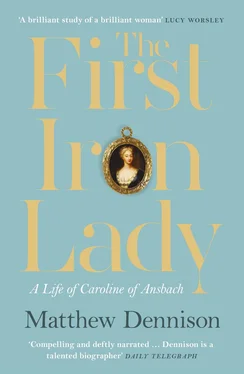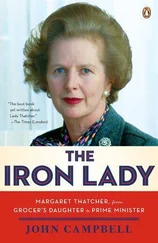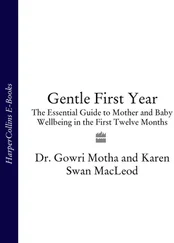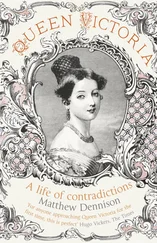Once, smallpox had deprived Eleonore of a doting husband. Now the disease struck again. ‘ Die Favoritin ’, Billa von Neitschütz, succumbed first. ‘For fear her face should suffer’, her mother dispensed with doctors (such as they were) and concocted remedies of her own. The result was ‘agonyes speechless’. As death approached, ‘locked jaws prevent[ed] [Billa] from taking the sacrament’. 43A grief-stricken John George ordered deep mourning for the entire court. 44Weeks later, on 27 April 1694, smallpox claimed John George’s life too, the price this headstrong and intemperate prince paid for nursing his mistress himself. 45In the medieval church of St Sophia, the corpse of die Favoritin was placed on public view, her face alarmingly discoloured. An eyewitness account survives from 30 April, more than two weeks after Billa’s death. 46So, too, a scurrilous epitaph on John George’s foolish mistress and her scheming and ambitious mother. 47
In 1692, George Stepney, then agent to the Brandenburg court, had correctly forecast a short life for the elector John George IV. His appointment the following year to the post of commissary and deputy to the court of Saxony offered Stepney ample opportunity for further observation. In the aftermath of John George’s death, he wrote an elegy to Eleonore, Pour la mort de SAE de Saxe à SAE Madame l’Electrice Eleonore . In it, he described the elector’s passion for Billa von Neitschütz as ‘unworthy’, their love ‘ un indigne amour ’. 48Finally free from the toxicity of mingled terror and humiliation, Eleonore’s only response was relief. In the witchcraft trial of Ursula von Neitschütz the following year she played no part.
Eleonore had endured the death of her first son. Sincerely she had mourned her first husband. With no option but to leave the palace in Ansbach, yet insufficiently provided for, she had spent almost six years lonely, unhappy and all but penniless in provincial retirement in Crailsheim. Velvet-gloved but iron-fisted cajolery on the part of her ‘friends’ had compelled her to marry again, this time a boor and a drunkard with a pronounced streak of mental cruelty. Either her second husband, or associates of her husband’s mistress, had threatened to poison her. John George himself had drawn his sword on her.
In Saxony, she was more fortunate than in Ansbach in her husband’s successor. John George’s heir, his brother Frederick Augustus, afterwards known as ‘Augustus the Strong’ on account of feats that included rolling up silver plates with his bare hands, ‘revel[led] and dance[d]’ at news of his death, then gave himself up to ‘frolicks and debauches’. 49In John George’s beautiful widow and her children he took a passing interest, as he would continue to do, and Eleonore’s life regained a semblance of normality. Among her surviving papers, for example, is the letter of recommendation – the equivalent of a reference – that she wrote in the summer of 1694 for a former page at Crailsheim. 50George Stepney reported in August that he had twice visited Eleonore since her widowhood, and that she permitted him to call on her frequently. On both occasions she had told him ‘old stories and some particulars of the disorders of the late reign which I should never have learn’d from anybody else’. 51The following summer, in company with Caroline, she revisited Dresden on her way to spas near Koblenz, and had supper with Stepney’s colleague Philip Plantamour. 52Her journey proved unhappy: ‘her wagons [were] plundered by snap-hawks [freebooters]’ and she was robbed of valuable plate and goods. 53
Whatever the anticipated benefits of Eleonore’s Koblenz trip, the damage, it seemed, had been done. In the interval since John Frederick’s death, her health had deteriorated irreparably. On 9 September 1696, two years after her second husband, Eleonore died. She was thirty-four years old. Her daughter Caroline, just thirteen, found herself an orphan.
A letter changed Caroline’s life. It took the form of an invitation, and offered her a home – her fifth so far – and the security of guardianship. Its author was the Elector of Brandenburg, Frederick III – to date, as the tone of his letter implicitly acknowledged, an equivocal player in the life of Caroline’s family. With some warmth, Frederick wrote to her in the autumn of 1696, ‘I will never fail as your guardian, to espouse your interests, and to care for you as a loving father, and pray your Highness to have in me the same confidence as your mother always had, which I shall properly endeavour to deserve.’ 54Events would prove his sincerity. Caroline had made her home in Berlin before, at Frederick’s glittering court, in the unsettled months preceding Eleonore’s disastrous remarriage. Now, insofar as the young Caroline could ever feel she dare anticipate stability, the shadow of unsettlement temporarily dispersed. Only her parting from her brother William Frederick increased her sorrow. He had returned to Ansbach as heir presumptive, following Christian Albert’s death in 1692 and the accession as margrave of the latter’s unmarried younger brother George Frederick.
Yet it was not the well-intentioned Frederick but his wife, Sophia Charlotte, a Hanoverian princess known to her family as ‘Figuelotte’, who would provide the guardianship that had the greatest impact on an impressionable young girl only fifteen years her junior. The elector was self-important, a little pompous, excessively absorbed by minutiae of etiquette and ceremony, a zealot for elaborate dress despite a spinal deformity and gout; in his own words one who possessed ‘all the attributes of kingliness and in greater measure than other kings’, alternatively one who ‘[went] out of his way to find more and more occasions for ceremony’. 55By contrast the electress disdained ‘the grandeurs and crowns of which people make so much here’; 56she described herself as well acquainted with ‘the infinitely little’. 57While Frederick was at pains to surround himself with a court as rigidly formal as Versailles, his wife – motivated ‘by the ardour that she had for the knowledge of the truth’ – preferred music, reading and ‘the charm of … philosophical conversations’. 58Court life, Figuelotte saw, threatened the truest friendships, the strongest bonds of love, however impassioned Frederick’s professed opposition to ‘Cabals and private Intrigues … [and] intermeddling in other People’s Business’. 59It offered, as the philosopher Leibniz noted, ‘everything that might dissipate the intellect’. 60She was impatient of Frederick’s hankering after royal gloire . And, until 1697, she had a powerful enemy in his close adviser and former tutor, Eberhard von Danckelmann. Studiedly detached from court politics, she occupied herself with less contentious pursuits.
To Agostino Steffani, her father’s director of court music in Hanover, Figuelotte described music as ‘a loyal friend that never leaves one and never deceives one, it never betrays one and has never been cruel. On the contrary all the charm and delight of heaven is there.’ 61Within months of Caroline’s arrival, Figuelotte had enticed to Berlin as court composer the Italian organist and former composer to the Duke of Mantua, Attilio Ariosti. From 1702 she employed the composer Giovanni Bononcini. Both would later feature in the operatic life of London after Caroline’s marriage. Among Figuelotte’s costliest purchases was a harpsichord, commissioned from the court instrument-maker Michael Mietke, sumptuously decorated with panels simulating white Chinese lacquer; she also commissioned a folding harpsichord to take with her on journeys. Frederick meanwhile devoted his energies to worldly aggrandisement. In 1701, in exchange for military support for Habsburg ambitions in Spain, he won the emperor’s acquiescence in his elevation from Elector of Brandenburg and Duke of Prussia to ‘King in Prussia’. The previous year, in anticipation, he had given orders for a new suite of crown jewels. Like other mythomanes, at his coronation at Königsberg on 18 January, he placed the crown on his own head.
Читать дальше












